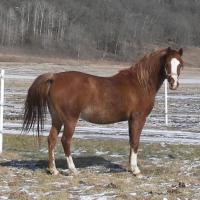Study of Face and Leg White in Horses Reveals Influence of New and Known Loci
An article was recently brought to my attention (via twitter) regarding the regulation of white markings in horses. This article was published today (December 12th) but the actual paper on which it was based was published back in September and somehow escaped my notice. While “TheHorse.com” article explains some of the reasons to test for white markings and why they are important it is sadly lacking in explaining what the researchers actually found and how those findings relate to white markings in horses.
How White Works
It has been theorized for many years that all white markings in horses are the result of a white pattern gene but this theory has been impossible to prove without knowing all possible white patterns. However, as the number of tests for white patterns increase, it has become apparent that expression of white patterns can vary greatly. Even white patterns that generally are easy to identify, in certain cases, can result in a horse that is solid, with literally no white. Because of the wide range of expression, it has become more and more likely that all white markings in horses are the result of some white pattern gene.
White markings in horses are formed when pigment producing cells (melanocytes) fail to migrate to their final location on an animal. The areas that are left without pigment producing cells remain white. Because pigment producing cells always migrate the same way, the areas of the body which are reached last by these cell during development are the areas of the body that are most likely to be white, ie the head and legs. There are certain genes that have been found to influence/interfere the migration of these melanocytes in horses. These genes are KIT, MITF, PAX3 and EDNRB. The Frame mutation (LWO) is found on EDNRB, the Splashed White mutations have been located on MITF and PAX3, but by far gene responsible for the most white patterns in horses is the KIT gene.
Which Genes are Responsible
Previous research has revealed that “normal” white markings are polygenic. This means that more one gene is involved in their expression. Of course determining how these genes work together becomes disproportionately more difficult as more genes are added to the mix. In order to study these polygenetic traits researchers used a A genome-wide association analysis.
This study compared the genomes of over 1,077 horses that were selected from the Swiss Franches-Montagnes horse population. These horses were then scored according to the amount of white they express. They then compared the horses by genome and white expression. While this type of genetic analysis does not locate specific mutations it does give an idea of where in a genome a causative mutation might be located. What they discovered was the single most important gene in the expression of “normal” white markings in the Franches-Montagnes horse population is close to the MITF gene. This means that it might be the MITF gene or a mutation very “near” to it in the genetic sense. Since this gene is responsible for the Splashed White 1 and Splashed White 3 (genetic tests are available) this result is not terribly surprising. The second most influential gene was located near the MC1R gene. MC1R is the gene is most often known as extension and is not a gene that causes white patterns. However, it has long been known that MC1R influences the expression of white patterns. Horses that are chestnut are homozygous for the recessive allele (ee) at extension and express more white then their counterparts that are Ee and EE at extension. The third most influential loci was located close to the KIT gene. The KIT gene is responsible for all of the Sabino and Dominant White mutations as well as Classic Roan and possibly Rabicano. It is on the same chromosome (chromosome 3) as extension and often travels with extension in a linked fashion. Other statistically significant loci where found on chromosomes 1, 3, 23, and 25, but do not correspond to any gene currently known to be responsible for white patterns in horses.
Interesting Results
The researchers found several interesting collations. The first of which is that KIT is more influential in chestnut horses while MITF is more influential in bay horses. This may be due to the fact that MC1R reduces the number of pigment cells making chestnut horses more susceptible to the effects of KIT. A second interesting correlation is that MITF influences head white more than KIT while KIT is more influential in leg white. This is likely due body and head pigment cells originating in separate locations thus being disproportionately influenced by either KIT or MITF. The researchers also theorized that the increase in white markings in the Franches-Montagnes Horses could be due to an accumulation of separate mutations since the breeds founding.
When all seven loci are included they accounted for approximately 54% of the white marking variation in the horses studied. With KIT responsible for 12% and MITF for 14%. Perhaps the most interesting result from the study was the identification of four previously unknown loci that could be responsible for a significant amount of white patterning in horses.
Novel variants in the KIT and PAX3 genes in horses with white-spotted coat colour phenotypes
Common White Facial Markings in Bay and Chestnut Arabian Horses and Their Hybrids


This is awesome info! Thanks
This is awesome info! Thanks so much for breaking down the findings. I'm off to read the article! ^_^